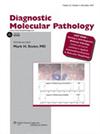Diagnostic molecular pathology: AIMMing higher.
引用次数: 0
Abstract
A lmost a quarter century ago (can it truly be that long?), Diagnostic Molecular Pathology (DMP) was created as the first forum for papers in diagnostic anatomic pathology that emphasized the use of molecular methods to enhance patient diagnosis and clinical management. I have had the privilege of serving as the Editorin-Chief of DMP for 14 of its 22 volumes. Over the last 15 years, but most especially in the last 5, the use of molecular methods in diagnostic anatomic pathology has witnessed remarkable growth and development. Today, molecular pathology laboratories are an integral part of most academic and many general practice departments. Coupled with the data derived from the human genome project and dramatic improvements in technology, the study of disease by means of molecular methods and the application of this knowledge for clinical diagnosis and prognostication are reshaping both biomedical research and general medical practice. This biomedical revolution is the field of molecular anatomic pathology and no one method dominates. Rather, all of the modern tools at the disposal of the pathologists, including tissue-based DNA and RNA extraction and amplification methods as well as morphology-based methods such as immunohistochemistry and in situ hybridization, routinely enhance the precision of our diagnostics and guide the selection of therapies for patient management. This dynamic evolution of molecular pathology continues to drive competition for the top-quality papers in our field. Indeed, molecular pathology topics are now the mainstream subject matter of virtually all pathology journals. Furthermore, the complementary nature of immunohistochemical and molecular methods in anatomic pathology diagnostics causes one to realize that emphasizing one class of methods to the potential exclusion of the other is no longer a good reflection of clinical practice. Thus, the time seems right to evolve and grow with the times to continue to bring our readers the very best and most relevant publications. How to do this was a bit complex and carefully considered. The strategy was to broaden the scope of articles and methods while also improving quality and importantly the frequency of publication to compete with journals publishing monthly in order to address the impact factor concerns of many of our authors. Working together with our publisher, the best overall solution became crystal clear. By merging the content of DMP with that of our sister journal, Applied Immunohistochemistry and Molecular Morphology (AIMM), the above goals could be achieved and expanded. The volume of manuscripts from both Journals will allow both expanded content and increased publication frequency while driving competitive quality and impact. Several months of behind-the-scenes work by the Publisher along with Dr Clive Taylor, the long-time Editor of AIMM and the Editor-in-Chief of the new improved AIMM, promises to provide the field with an outstanding platform for publications in our dynamic field. So, dear reader, thank you! It has been a true privilege to serve as DMP’s editor and, through this Journal, help the field of molecular diagnostic evolve and mature. And now with AIMM, the field of molecular anatomic pathology will move to an even higher level. We appreciate your loyalty and, more importantly, welcome the contribution of your best work to Applied Immunohistochemistry and Molecular Morphology. So as you see it is not truly a farewell to DMP. Rather together, we are all AIMMing higher.诊断性分子病理学:目标较高。
本文章由计算机程序翻译,如有差异,请以英文原文为准。
求助全文
约1分钟内获得全文
求助全文
来源期刊
自引率
0.00%
发文量
0
审稿时长
>12 weeks
期刊介绍:
Diagnostic Molecular Pathology focuses on providing clinical and academic pathologists with coverage of the latest molecular technologies, timely reviews of established techniques, and papers on the applications of these methods to all aspects of surgical pathology and laboratory medicine. It publishes original, peer-reviewed contributions on molecular probes for diagnosis, such as tumor suppressor genes, oncogenes, the polymerase chain reaction (PCR), and in situ hybridization. Articles demonstrate how these highly sensitive techniques can be applied for more accurate diagnosis.

 求助内容:
求助内容: 应助结果提醒方式:
应助结果提醒方式:


